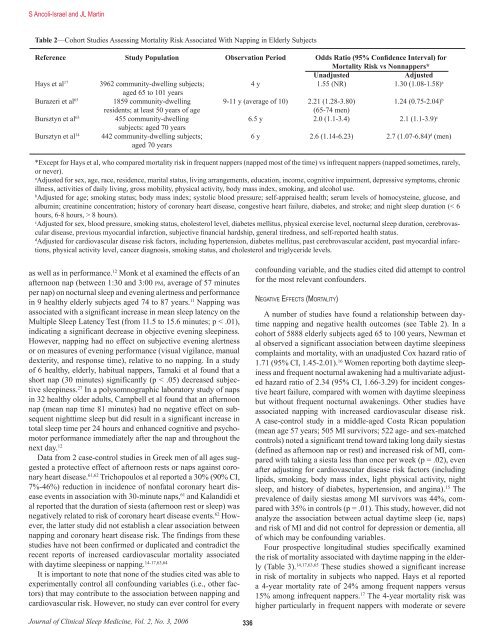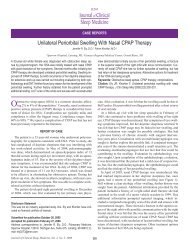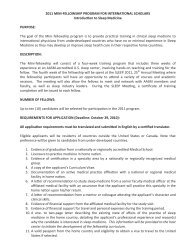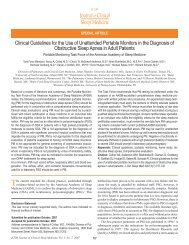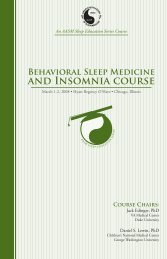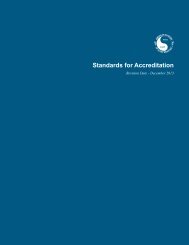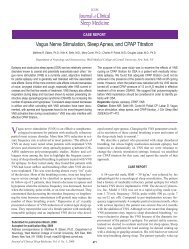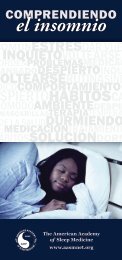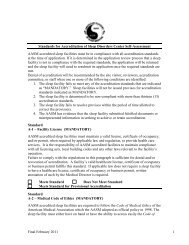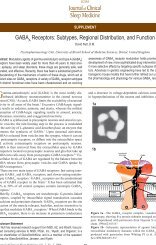Insomnia and Daytime Napping in Older Adults - ResearchGate
Insomnia and Daytime Napping in Older Adults - ResearchGate
Insomnia and Daytime Napping in Older Adults - ResearchGate
Create successful ePaper yourself
Turn your PDF publications into a flip-book with our unique Google optimized e-Paper software.
S Ancoli-Israel <strong>and</strong> JL Mart<strong>in</strong><br />
Table 2—Cohort Studies Assess<strong>in</strong>g Mortality Risk Associated With <strong>Napp<strong>in</strong>g</strong> <strong>in</strong> Elderly Subjects<br />
Reference Study Population Observation Period Odds Ratio (95% Confidence Interval) for<br />
Mortality Risk vs Nonnappers*<br />
Unadjusted<br />
Adjusted<br />
Hays et al 17 3962 community-dwell<strong>in</strong>g subjects; 4 y 1.55 (NR) 1.30 (1.08-1.58) a<br />
aged 65 to 101 years<br />
Burazeri et al 65 1859 community-dwell<strong>in</strong>g 9-11 y (average of 10) 2.21 (1.28-3.80) 1.24 (0.75-2.04) b<br />
residents; at least 50 years of age<br />
(65-74 men)<br />
Bursztyn et al 63 455 community-dwell<strong>in</strong>g 6.5 y 2.0 (1.1-3.4) 2.1 (1.1-3.9) c<br />
subjects: aged 70 years<br />
Bursztyn et al 14 442 community-dwell<strong>in</strong>g subjects; 6 y 2.6 (1.14-6.23) 2.7 (1.07-6.84) d (men)<br />
aged 70 years<br />
*Except for Hays et al, who compared mortality risk <strong>in</strong> frequent nappers (napped most of the time) vs <strong>in</strong>frequent nappers (napped sometimes, rarely,<br />
or never).<br />
a<br />
Adjusted for sex, age, race, residence, marital status, liv<strong>in</strong>g arrangements, education, <strong>in</strong>come, cognitive impairment, depressive symptoms, chronic<br />
illness, activities of daily liv<strong>in</strong>g, gross mobility, physical activity, body mass <strong>in</strong>dex, smok<strong>in</strong>g, <strong>and</strong> alcohol use.<br />
b<br />
Adjusted for age; smok<strong>in</strong>g status; body mass <strong>in</strong>dex; systolic blood pressure; self-appraised health; serum levels of homocyste<strong>in</strong>e, glucose, <strong>and</strong><br />
album<strong>in</strong>; creat<strong>in</strong><strong>in</strong>e concentration; history of coronary heart disease, congestive heart failure, diabetes, <strong>and</strong> stroke; <strong>and</strong> night sleep duration (< 6<br />
hours, 6-8 hours, > 8 hours).<br />
c<br />
Adjusted for sex, blood pressure, smok<strong>in</strong>g status, cholesterol level, diabetes mellitus, physical exercise level, nocturnal sleep duration, cerebrovascular<br />
disease, previous myocardial <strong>in</strong>farction, subjective f<strong>in</strong>ancial hardship, general tiredness, <strong>and</strong> self-reported health status.<br />
d<br />
Adjusted for cardiovascular disease risk factors, <strong>in</strong>clud<strong>in</strong>g hypertension, diabetes mellitus, past cerebrovascular accident, past myocardial <strong>in</strong>farctions,<br />
physical activity level, cancer diagnosis, smok<strong>in</strong>g status, <strong>and</strong> cholesterol <strong>and</strong> triglyceride levels.<br />
as well as <strong>in</strong> performance. 12 Monk et al exam<strong>in</strong>ed the effects of an<br />
afternoon nap (between 1:30 <strong>and</strong> 3:00 PM, average of 57 m<strong>in</strong>utes<br />
per nap) on nocturnal sleep <strong>and</strong> even<strong>in</strong>g alertness <strong>and</strong> performance<br />
<strong>in</strong> 9 healthy elderly subjects aged 74 to 87 years. 11 <strong>Napp<strong>in</strong>g</strong> was<br />
associated with a significant <strong>in</strong>crease <strong>in</strong> mean sleep latency on the<br />
Multiple Sleep Latency Test (from 11.5 to 15.6 m<strong>in</strong>utes; p < .01),<br />
<strong>in</strong>dicat<strong>in</strong>g a significant decrease <strong>in</strong> objective even<strong>in</strong>g sleep<strong>in</strong>ess.<br />
However, napp<strong>in</strong>g had no effect on subjective even<strong>in</strong>g alertness<br />
or on measures of even<strong>in</strong>g performance (visual vigilance, manual<br />
dexterity, <strong>and</strong> response time), relative to no napp<strong>in</strong>g. In a study<br />
of 6 healthy, elderly, habitual nappers, Tamaki et al found that a<br />
short nap (30 m<strong>in</strong>utes) significantly (p < .05) decreased subjective<br />
sleep<strong>in</strong>ess. 27 In a polysomnographic laboratory study of naps<br />
<strong>in</strong> 32 healthy older adults, Campbell et al found that an afternoon<br />
nap (mean nap time 81 m<strong>in</strong>utes) had no negative effect on subsequent<br />
nighttime sleep but did result <strong>in</strong> a significant <strong>in</strong>crease <strong>in</strong><br />
total sleep time per 24 hours <strong>and</strong> enhanced cognitive <strong>and</strong> psychomotor<br />
performance immediately after the nap <strong>and</strong> throughout the<br />
next day. 12<br />
Data from 2 case-control studies <strong>in</strong> Greek men of all ages suggested<br />
a protective effect of afternoon rests or naps aga<strong>in</strong>st coronary<br />
heart disease. 61,62 Trichopoulos et al reported a 30% (90% CI,<br />
7%-46%) reduction <strong>in</strong> <strong>in</strong>cidence of nonfatal coronary heart disease<br />
events <strong>in</strong> association with 30-m<strong>in</strong>ute naps, 61 <strong>and</strong> Kal<strong>and</strong>idi et<br />
al reported that the duration of siesta (afternoon rest or sleep) was<br />
negatively related to risk of coronary heart disease events. 62 However,<br />
the latter study did not establish a clear association between<br />
napp<strong>in</strong>g <strong>and</strong> coronary heart disease risk. The f<strong>in</strong>d<strong>in</strong>gs from these<br />
studies have not been confirmed or duplicated <strong>and</strong> contradict the<br />
recent reports of <strong>in</strong>creased cardiovascular mortality associated<br />
with daytime sleep<strong>in</strong>ess or napp<strong>in</strong>g. 14-17,63,64<br />
It is important to note that none of the studies cited was able to<br />
experimentally control all confound<strong>in</strong>g variables (i.e., other factors)<br />
that may contribute to the association between napp<strong>in</strong>g <strong>and</strong><br />
cardiovascular risk. However, no study can ever control for every<br />
confound<strong>in</strong>g variable, <strong>and</strong> the studies cited did attempt to control<br />
for the most relevant confounders.<br />
NEGATIVE EFFECTS (MORTALITY)<br />
A number of studies have found a relationship between daytime<br />
napp<strong>in</strong>g <strong>and</strong> negative health outcomes (see Table 2). In a<br />
cohort of 5888 elderly subjects aged 65 to 100 years, Newman et<br />
al observed a significant association between daytime sleep<strong>in</strong>ess<br />
compla<strong>in</strong>ts <strong>and</strong> mortality, with an unadjusted Cox hazard ratio of<br />
1.71 (95% CI, 1.45-2.01). 16 Women report<strong>in</strong>g both daytime sleep<strong>in</strong>ess<br />
<strong>and</strong> frequent nocturnal awaken<strong>in</strong>g had a multivariate adjusted<br />
hazard ratio of 2.34 (95% CI, 1.66-3.29) for <strong>in</strong>cident congestive<br />
heart failure, compared with women with daytime sleep<strong>in</strong>ess<br />
but without frequent nocturnal awaken<strong>in</strong>gs. Other studies have<br />
associated napp<strong>in</strong>g with <strong>in</strong>creased cardiovascular disease risk.<br />
A case-control study <strong>in</strong> a middle-aged Costa Rican population<br />
(mean age 57 years; 505 MI survivors; 522 age- <strong>and</strong> sex-matched<br />
controls) noted a significant trend toward tak<strong>in</strong>g long daily siestas<br />
(def<strong>in</strong>ed as afternoon nap or rest) <strong>and</strong> <strong>in</strong>creased risk of MI, compared<br />
with tak<strong>in</strong>g a siesta less than once per week (p = .02), even<br />
after adjust<strong>in</strong>g for cardiovascular disease risk factors (<strong>in</strong>clud<strong>in</strong>g<br />
lipids, smok<strong>in</strong>g, body mass <strong>in</strong>dex, light physical activity, night<br />
sleep, <strong>and</strong> history of diabetes, hypertension, <strong>and</strong> ang<strong>in</strong>a). 15 The<br />
prevalence of daily siestas among MI survivors was 44%, compared<br />
with 35% <strong>in</strong> controls (p = .01). This study, however, did not<br />
analyze the association between actual daytime sleep (ie, naps)<br />
<strong>and</strong> risk of MI <strong>and</strong> did not control for depression or dementia, all<br />
of which may be confound<strong>in</strong>g variables.<br />
Four prospective longitud<strong>in</strong>al studies specifically exam<strong>in</strong>ed<br />
the risk of mortality associated with daytime napp<strong>in</strong>g <strong>in</strong> the elderly<br />
(Table 3). 14,17,63,65 These studies showed a significant <strong>in</strong>crease<br />
<strong>in</strong> risk of mortality <strong>in</strong> subjects who napped. Hays et al reported<br />
a 4-year mortality rate of 24% among frequent nappers versus<br />
15% among <strong>in</strong>frequent nappers. 17 The 4-year mortality risk was<br />
higher particularly <strong>in</strong> frequent nappers with moderate or severe<br />
Journal of Cl<strong>in</strong>ical Sleep Medic<strong>in</strong>e, Vol. 2, No. 3, 2006 336


